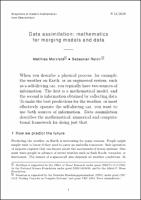| dc.contributor.author | Morzfeld, Matthias | |
| dc.contributor.author | Reich, Sebastian | |
| dc.contributor.editor | Munday, Sara | |
| dc.contributor.editor | Cederbaum, Carla | |
| dc.date.accessioned | 2018-07-10T10:49:07Z | |
| dc.date.available | 2018-07-10T10:49:07Z | |
| dc.date.issued | 2018-07-10 | |
| dc.identifier.uri | http://publications.mfo.de/handle/mfo/1375 | |
| dc.description.abstract | When you describe a physical process, for example,
the weather on Earth, or an engineered system, such
as a self-driving car, you typically have two sources of
information. The first is a mathematical model, and
the second is information obtained by collecting data.
To make the best predictions for the weather, or most
effectively operate the self-driving car, you want to
use both sources of information. Data assimilation
describes the mathematical, numerical and computational
framework for doing just that. | en_US |
| dc.language.iso | en | en_US |
| dc.publisher | Mathematisches Forschungsinstitut Oberwolfach | en_US |
| dc.relation.ispartofseries | Snapshots of modern mathematics from Oberwolfach;2018,11 | |
| dc.rights | Attribution-ShareAlike 4.0 International | * |
| dc.rights.uri | http://creativecommons.org/licenses/by-sa/4.0/ | * |
| dc.title | Data assimilation: mathematics for merging models and data | en_US |
| dc.type | Article | en_US |
| dc.identifier.doi | 10.14760/SNAP-2018-011-EN | |
| local.series.id | SNAP-2018-011-EN | en_US |
| local.subject.snapshot | Numerics and Scientific Computing | en_US |
| dc.identifier.urn | urn:nbn:de:101:1-2018071014410120244356 | |
| dc.identifier.ppn | 1654475114 | |


